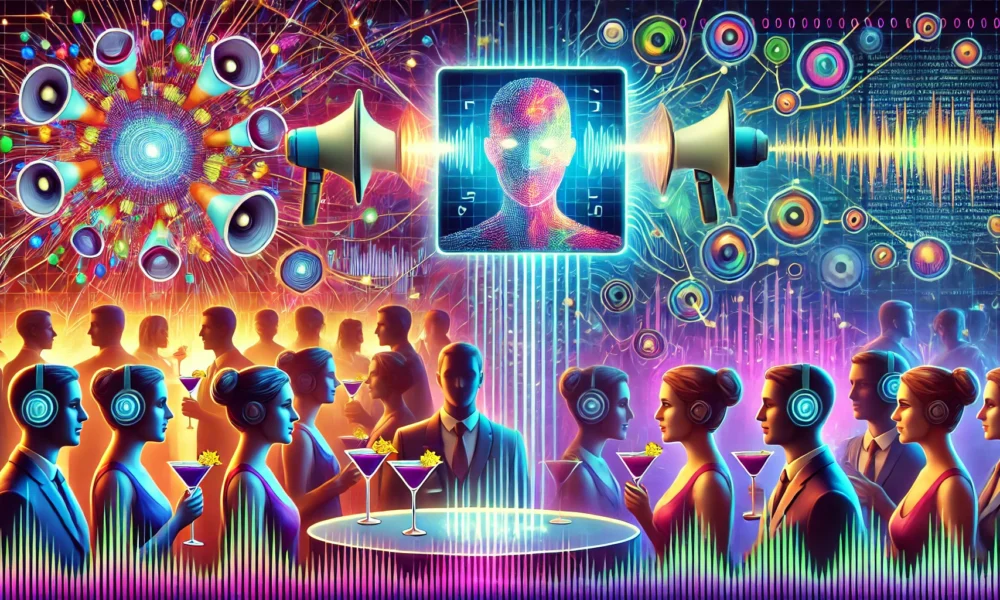The Revolutionary Impact of AI on the Cocktail Party Problem
Picture yourself in a bustling event, surrounded by chatter and noise, yet you can effortlessly focus on a single conversation. This remarkable skill to isolate specific sounds from a noisy background is known as the Cocktail Party Problem. While replicating this human ability in machines has long been a challenge, recent advances in artificial intelligence are paving the way for groundbreaking solutions. In this article, we delve into how AI is transforming the audio landscape by tackling the Cocktail Party Problem.
The Human Approach to the Cocktail Party Problem
Humans possess a sophisticated auditory system that enables us to navigate noisy environments effortlessly. Through binaural processing, we use inputs from both ears to detect subtle differences in timing and volume, aiding in identifying sound sources. This innate ability, coupled with cognitive functions like selective attention, context, memory, and visual cues, allows us to prioritize important sounds amidst a cacophony of noise. While our brains excel at this complex task, replicating it in AI has proven challenging.
AI’s Struggle with the Cocktail Party Problem
AI researchers have long strived to mimic the human brain’s ability to solve the Cocktail Party Problem, employing techniques like blind source separation and Independent Component Analysis. While these methods show promise in controlled environments, they falter when faced with overlapping voices or dynamically changing soundscapes. The absence of sensory and contextual depth hampers AI’s capability to manage the intricate mix of sounds encountered in real-world scenarios.
WaveSciences’ AI Breakthrough
In a significant breakthrough, WaveSciences introduced Spatial Release from Masking (SRM), harnessing AI and sound physics to isolate a speaker’s voice from background noise. By leveraging multiple microphones and AI algorithms, SRM can track sound waves’ spatial origin, offering a dynamic and adaptive solution to the Cocktail Party Problem. This advancement not only enhances conversation clarity in noisy environments but also sets the stage for transformative innovations in audio technology.
Advancements in AI Techniques
Recent strides in deep neural networks have vastly improved machines’ ability to unravel the Cocktail Party Problem. Projects like BioCPPNet showcase AI’s prowess in isolating sound sources, even in complex scenarios. Neural beamforming and time-frequency masking further amplify AI’s capabilities, enabling precise voice separation and enhanced model robustness. These advancements have diverse applications, from forensic analysis to telecommunications and audio production.
Real-world Impact and Applications
AI’s progress in addressing the Cocktail Party Problem has far-reaching implications across various industries. From enhancing noise-canceling headphones and hearing aids to improving telecommunications and voice assistants, AI is revolutionizing how we interact with sound. These advancements not only elevate everyday experiences but also open doors to innovative applications in forensic analysis, telecommunications, and audio production.
Embracing the Future of Audio Technology with AI
The Cocktail Party Problem, once a challenge in audio processing, has now become a realm of innovation through AI. As technology continues to evolve, AI’s ability to mimic human auditory capabilities will drive unprecedented advancements in audio technologies, reshaping our interaction with sound in profound ways.
-
What is the ‘Cocktail Party Problem’ in audio technologies?
The ‘Cocktail Party Problem’ refers to the challenge of isolating and understanding individual audio sources in a noisy or crowded environment, much like trying to focus on one conversation at a busy cocktail party. -
How does AI solve the ‘Cocktail Party Problem’?
AI uses advanced algorithms and machine learning techniques to separate and amplify specific audio sources, making it easier to distinguish and understand individual voices or sounds in a noisy environment. -
What impact does AI have on future audio technologies?
AI has the potential to revolutionize the way we interact with audio technologies, by improving speech recognition, enhancing sound quality, and enabling more personalized and immersive audio experiences in a variety of settings. -
Can AI be used to enhance audio quality in noisy environments?
Yes, AI can be used to filter out background noise, improve speech clarity, and enhance overall audio quality in noisy environments, allowing for better communication and listening experiences. - How can businesses benefit from AI solutions to the ‘Cocktail Party Problem’?
Businesses can use AI-powered audio technologies to improve customer service, enhance communication in noisy work environments, and enable more effective collaboration and information-sharing among employees.
Related posts:
- Introducing OpenAI o1: Advancing AI’s Reasoning Abilities for Complex Problem Solving
- Introducing Stable Audio 2.0 by Stability AI: Enhancing Creator’s Tools with Advanced AI-Generated Audio
- The Tech Industry’s Shift Towards Nuclear Power in Response to AI’s Increasing Energy Demands
- Redefining the Future of Architecture with Generative AI Blueprints


No comment yet, add your voice below!